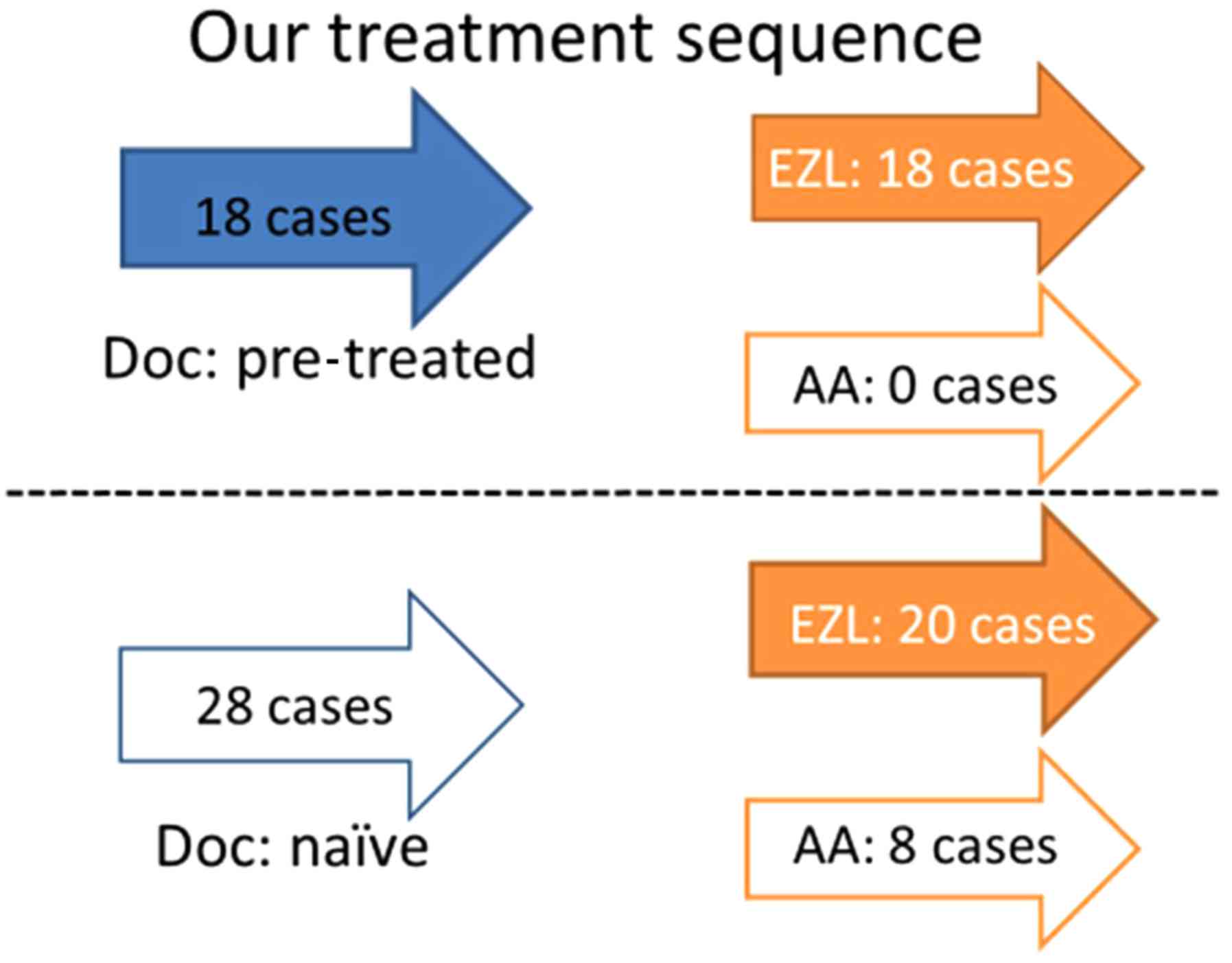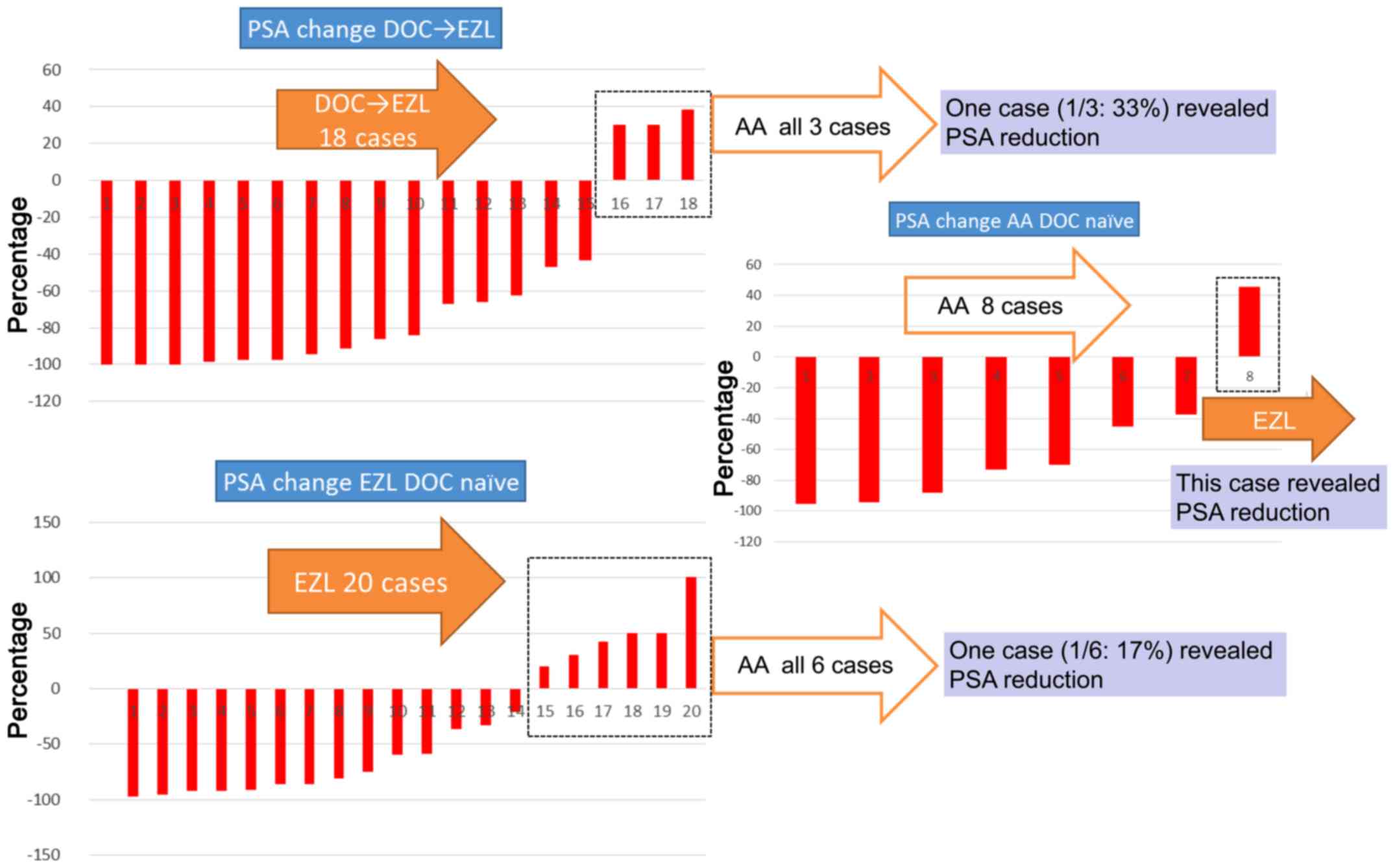|
1
|
Gartrell BA and Saad F: Abiraterone in the
management of castration-resistant prostate cancer prior to
chemotherapy. Ther Adv Urol. 7:194–202. 2015. View Article : Google Scholar : PubMed/NCBI
|
|
2
|
Kirby M, Hirst C and Crawford ED:
Characterising the castration-resistant prostate cancer population:
A systematic review. Int J Clin Pract. 65:1180–1192. 2011.
View Article : Google Scholar : PubMed/NCBI
|
|
3
|
McCrea E, Sissung TM, Price DK, Chau CH
and Figg WD: Androgen receptor variation affects prostate cancer
progression and drug resistance. Pharmacol Res. 114:152–162. 2016.
View Article : Google Scholar : PubMed/NCBI
|
|
4
|
Joensuu T, Joensuu G, Kairemo K, Kiljunen
T, Riener M, Aaltonen A, Ala-Opas M, Kangasmäki A, Alanko T,
Taipale L, et al: Multimodal primary treatment of metastatic
prostate cancer with androgen deprivation and radiation. Anticancer
Res. 36:6439–6447. 2016. View Article : Google Scholar : PubMed/NCBI
|
|
5
|
Cicero G, De Luca R, Dorangricchia P,
Galvano A, Lo Re G, Serretta V, Dispensa N and Dieli F: Cabazitaxel
in metastatic castration-resistant prostate cancer patients
progressing after docetaxel: A prospective single-center study.
Oncology. 92:94–100. 2017. View Article : Google Scholar : PubMed/NCBI
|
|
6
|
Hu R, George DJ and Zhang T: What is the
role of sipuleucel-T in the treatment of patients with advanced
prostate cancer? An update on the evidence. Ther Adv Urol.
8:272–278. 2016. View Article : Google Scholar : PubMed/NCBI
|
|
7
|
Carton E, Noe G, Huillard O, Golmard L,
Giroux J, Cessot A, Saidu NE, Peyromaure M, Zerbib M, Narjoz C, et
al: Relation between plasma trough concentration of abiraterone and
prostate-specific antigen response in metastatic
castration-resistant prostate cancer patients. Eur J Cancer.
72:54–61. 2017. View Article : Google Scholar : PubMed/NCBI
|
|
8
|
Scher HI, Fizazi K, Saad F, Taplin ME,
Sternberg CN, Miller K, de Wit R, Mulders P, Chi KN, Shore ND, et
al: Increased survival with enzalutamide in prostate cancer after
chemotherapy. N Engl J Med. 367:1187–1197. 2012. View Article : Google Scholar : PubMed/NCBI
|
|
9
|
Saad F: Evidence for the efficacy of
enzalutamide in postchemotherapy metastatic castrate-resistant
prostate cancer. Ther Adv Urol. 5:201–210. 2013. View Article : Google Scholar : PubMed/NCBI
|
|
10
|
Parker C, Zhan L, Cislo P, Reuning-Scherer
J, Vogelzang NJ, Nilsson S, Sartor O, O'Sullivan JM and Coleman RE:
Effect of radium-223 dichloride (Ra-223) on hospitalisation: An
analysis from the phase 3 randomised Alpharadin in symptomatic
prostate cancer patients (ALSYMPCA) trial. Eur J Cancer. 71:1–6.
2017. View Article : Google Scholar : PubMed/NCBI
|
|
11
|
Akaza H: Influences of the results from
STRIVE trial on the combination androgen depletion therapy for
advanced prostate cancer. Curr Urol Rep. 17:842016. View Article : Google Scholar : PubMed/NCBI
|
|
12
|
Badrising SK, van der Noort V, van den
Eertwegh AJ, Hamberg P, van Oort IM, van den Berg HP, Los M, Aarts
MJ, Coenen JL, Gelderblom H, et al: Prognostic parameters for
response to enzalutamide after docetaxel and abiraterone treatment
in metastatic castration-resistant prostate cancer patients; a
possible time relation. Prostate. 76:32–40. 2016. View Article : Google Scholar : PubMed/NCBI
|
|
13
|
Sweeney CJ, Chen YH, Carducci M, Liu G,
Jarrard DF, Eisenberger M, Wong YN, Hahn N, Kohli M, Cooney MM, et
al: Chemohormonal therapy in metastatic hormone-sensitive prostate
cancer. N Engl J Med. 373:737–746. 2015. View Article : Google Scholar : PubMed/NCBI
|
|
14
|
Oudard S, Kramer G, Caffo O, Creppy L,
Loriot Y, Hansen S, Holmberg M, Rolland F, Machiels JP and Krainer
M: Docetaxel rechallenge after an initial good response in patients
with metastatic castration-resistant prostate cancer. BJU Int.
115:744–752. 2015. View Article : Google Scholar : PubMed/NCBI
|
|
15
|
Verzoni E, De Giorgi U, Derosa L, Caffo O,
Boccardo F, Facchini G, Porcu L, De Vincenzo F, Zaniboni A, Chiuri
VE, et al: Predictors of long-term response to abiraterone in
patients with metastastic castration-resistant prostate cancer: A
retrospective cohort study. Oncotarget. 7:40085–40094. 2016.
View Article : Google Scholar : PubMed/NCBI
|
|
16
|
Lohiya V, Aragon-Ching JB and Sonpavde G:
Role of chemotherapy and mechanisms of resistance to chemotherapy
in metastatic castration-resistant prostate cancer. Clin Med
Insights Oncol. 10 Suppl 1:S57–S66. 2016.
|
|
17
|
Antonarakis ES, Lu C, Wang H, Luber B,
Nakazawa M, Roeser JC, Chen Y, Mohammad TA, Chen Y, Fedor HL, et
al: AR-V7 and resistance to enzalutamide and abiraterone in
prostate cancer. N Engl J Med. 371:1028–1038. 2014. View Article : Google Scholar : PubMed/NCBI
|
|
18
|
Antonarakis ES, Lu C, Luber B, Wang H,
Chen Y, Nakazawa M, Nadal R, Paller CJ, Denmeade SR, Carducci MA,
et al: Androgen receptor splice variant 7 and efficacy of Taxane
chemotherapy in patients with metastatic castration-resistant
prostate cancer. JAMA Oncol. 1:582–591. 2015. View Article : Google Scholar : PubMed/NCBI
|











